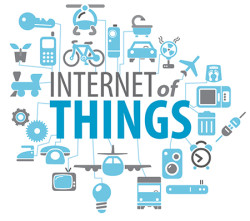Forget Netflix – The Fifth Generation of Wireless Is About Connecting Everything
 I was on the phone last night with a colleague (who prefers to remain nameless) from the computer networking world. He’s both a scientist and an engineer I respect, so when the conversation turned to the future of wireless media and the wireless network in general, I grabbed a pen.
I was on the phone last night with a colleague (who prefers to remain nameless) from the computer networking world. He’s both a scientist and an engineer I respect, so when the conversation turned to the future of wireless media and the wireless network in general, I grabbed a pen.
We discussed the implications of next generation of wireless technologies as they are deployed around the world. The fifth generation of wireless represents a dramatic upgrade from the already impressive 4G networks of today. A 4G network can provide 100 Mbps (Megabits per second) — plenty of bandwidth to download video, stream application data, and upload your latest Vine. Wireless has encircled most of civilization and 4G is fast becoming the standard. By 2020, 85 percent of the world will have at least a 3G connection, while 60 percent of the world will be on a 4G network. 4G has already changed how we interact with our computational environments and the media we store. For instance, Subaru has plans to introduce 4G LTE connections in select 2016 model cars. Pervasive and fast, 4G was transformational. It helped usher in cloud storage, the rise of the tablet, and the end of the video cable — which is why we built Solstice in the anticipation that wireless would transform how we access and use displays.
It’s interesting to consider then, what will 5G mean? What paradigms will it challenge? What technologies will rise with 5G connectivity and what new applications will we have access to that don’t exist today? I have to admit, it was an interesting conversation and there are parts of it that I promised I’d keep to myself. However, there are some interesting implications that I and others have already discussed. Of course, there will be obvious implications related to the ability to download data faster. The ability to download at the peak bandwidth of 4G’s 150 megabits per second will increase to about 10 Gigabits per second. That’s fast enough to reduce 10+ minutes of downloading movies to less than 10 seconds — very cool, but hardly revolutionary.
 A more important implication will be how 5G can be leveraged to enable the Internet of Things (IoT). In short, the IoT is the concept that devices can produce interesting data about themselves and communicate directly with one another over wireless networks, enabling a new class of valuable applications. For example, objects could communicate their name and position to cars that are driving-by, enabling augmented reality windshields that we only dreamed about ten years ago. Apparently, there are some analysts that are predicting the IoT means the introduction of 25 billion new connected devices by the year 2020. These devices will be generating tremendous amounts of data and communications traffic — they’ll be sharing real-time biometrics to your treadmill, positional information from a dog collar, security status from your in-home devices… the list goes on. As these devices come online they’ll drive demand for 5G networks, after all, carriers will not deploy 5G until they see demand. There will be a synchronous cycle between the growth of the IoT and the spread of 5G networks.
A more important implication will be how 5G can be leveraged to enable the Internet of Things (IoT). In short, the IoT is the concept that devices can produce interesting data about themselves and communicate directly with one another over wireless networks, enabling a new class of valuable applications. For example, objects could communicate their name and position to cars that are driving-by, enabling augmented reality windshields that we only dreamed about ten years ago. Apparently, there are some analysts that are predicting the IoT means the introduction of 25 billion new connected devices by the year 2020. These devices will be generating tremendous amounts of data and communications traffic — they’ll be sharing real-time biometrics to your treadmill, positional information from a dog collar, security status from your in-home devices… the list goes on. As these devices come online they’ll drive demand for 5G networks, after all, carriers will not deploy 5G until they see demand. There will be a synchronous cycle between the growth of the IoT and the spread of 5G networks.
In our much smaller world we’ll continue to watch the IoT to determine what it means for our more specific interests — the future of audio/video systems. We’ve already seen emerging technologies shift industry paradigms. After all, our wireless media streaming technology was there at the beginning of the end of the video cable, which changed how people share media to their displays. We are also witnessing the rise of 5G and the resulting phenomena of the Internet of Things, which will have similar implications. Although it’s too early to go into detail on what 5G will mean for wireless collaboration specifically, I do think it’ll introduce a new era of A/V – one I like to call the “Internet of Screens.”





